weight MERCEDES-BENZ C-Class COUPE 2017 CL205 Owner's Manual
[x] Cancel search | Manufacturer: MERCEDES-BENZ, Model Year: 2017, Model line: C-Class COUPE, Model: MERCEDES-BENZ C-Class COUPE 2017 CL205Pages: 354, PDF Size: 8.66 MB
Page 21 of 354
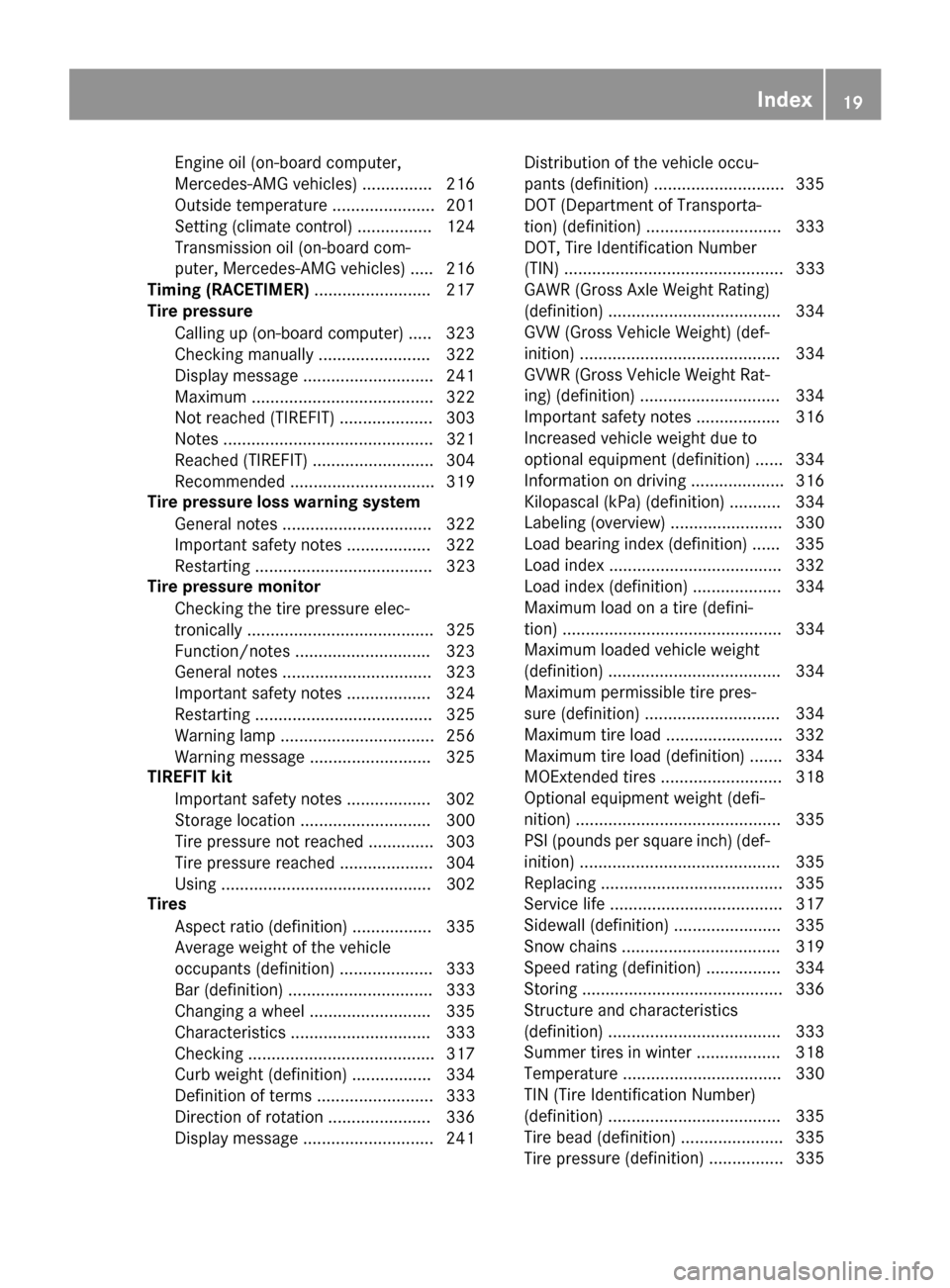
Engine oil(on -boar dcomputer,
Mercedes-AMGv ehicles)............... 216
Outside temperatur e...................... 201
Setting (climate control) ................ 124
Transmission oi l(on -boar dcom-
puter, Mercedes-AMGv ehicles)..... 216
Timing (RACETIMER) .........................217
Tire pressure
Calling up (on-board computer) ..... 323
Checking manually ........................ 322
Display message ............................ 241
Maximum ....................................... 322
Not reached (TIREFIT) .................... 303
Notes ............................................. 321
Reached (TIREFIT) .......................... 304
Recommended ............................... 319
Tire pressure los swarning system
General notes ................................ 322
Important safety notes .................. 322
Restarting ...................................... 323
Tire pressure monitor
Checking the tire pressure elec-
tronically ........................................ 325
Function/notes .............................3 23
General notes ................................ 323
Important safety notes .................. 324
Restarting ...................................... 325
Warning lamp ................................. 256
Warning message .......................... 325
TIREFIT kit
Important safety notes .................. 302
Storage location ............................ 300
Tire pressure not reached .............. 303
Tire pressure reached .................... 304
Using ............................................. 302
Tires
Aspect ratio (definition) ................. 335
Averag eweight of the vehicle
occupants (definition) .................... 333
Bar (definition) ............................... 333
Changing awheel .......................... 335
Characteristics .............................. 333
Checking ........................................ 317
Curb weight (definition) ................. 334
Definition of terms ......................... 333
Direction of rotatio n...................... 336
Disp la
y
m essage ............................ 241 Distribution of the vehicl
eoccu-
pants (definition) ............................ 335
DOT (Department of Transporta-
tion) (definition) ............................. 333
DOT, Tire Identification Number
(TIN) ............................................... 333
GAW R(GrossA xle Weight Rating)
(definition) ..................................... 334
GV W( GrossV ehicl eWeight) (def-
inition) ........................................... 334
GVWR (Gros sVehicl eWeight Rat-
ing )(de finition) .............................. 334
Important safety notes .................. 316
Increased vehicl eweigh tdue to
optionale quipment (definition) ...... 334
Information on driving .................... 316
Kilopascal( kPa)(de finition) ........... 334
Labeling (overview) ........................ 330
Loadb earing index (definition) ...... 335
Loadi ndex ..................................... 332
Loadi ndex (definition) ................... 334
Maximu mloadona tire (defini-
tion) ............................................... 334
Maximu mloaded vehicleweigh t
(definition) ..................................... 334
Maximu mpermissibl etire pres-
sure (definition) ............................. 334
Maximu mtire load ......................... 332
Maximu mtire load (definition) ....... 334
MOExtended tire s.......................... 318
Optionale quipmentweight (defi-
nition) ............................................ 335
PSI (pounds pe rsquare inch )(de f-
inition) ........................................... 335
Replacing ....................................... 335
Service life ..................................... 317
Sidewal l(de finition) ....................... 335
Snow chains .................................. 319
Speed rating (definition) ................ 334
Storing ........................................... 336
Structure and characteristics
(definition) ..................................... 333
Summer tire sinwinter .................. 318
Temperature .................................. 330
TIN (Tire Identification Number)
(definition) ..................................... 335
Tire bead (definition) ...................... 335
Tire pre ssure (
definition) ................ 335
Index19
Page 27 of 354
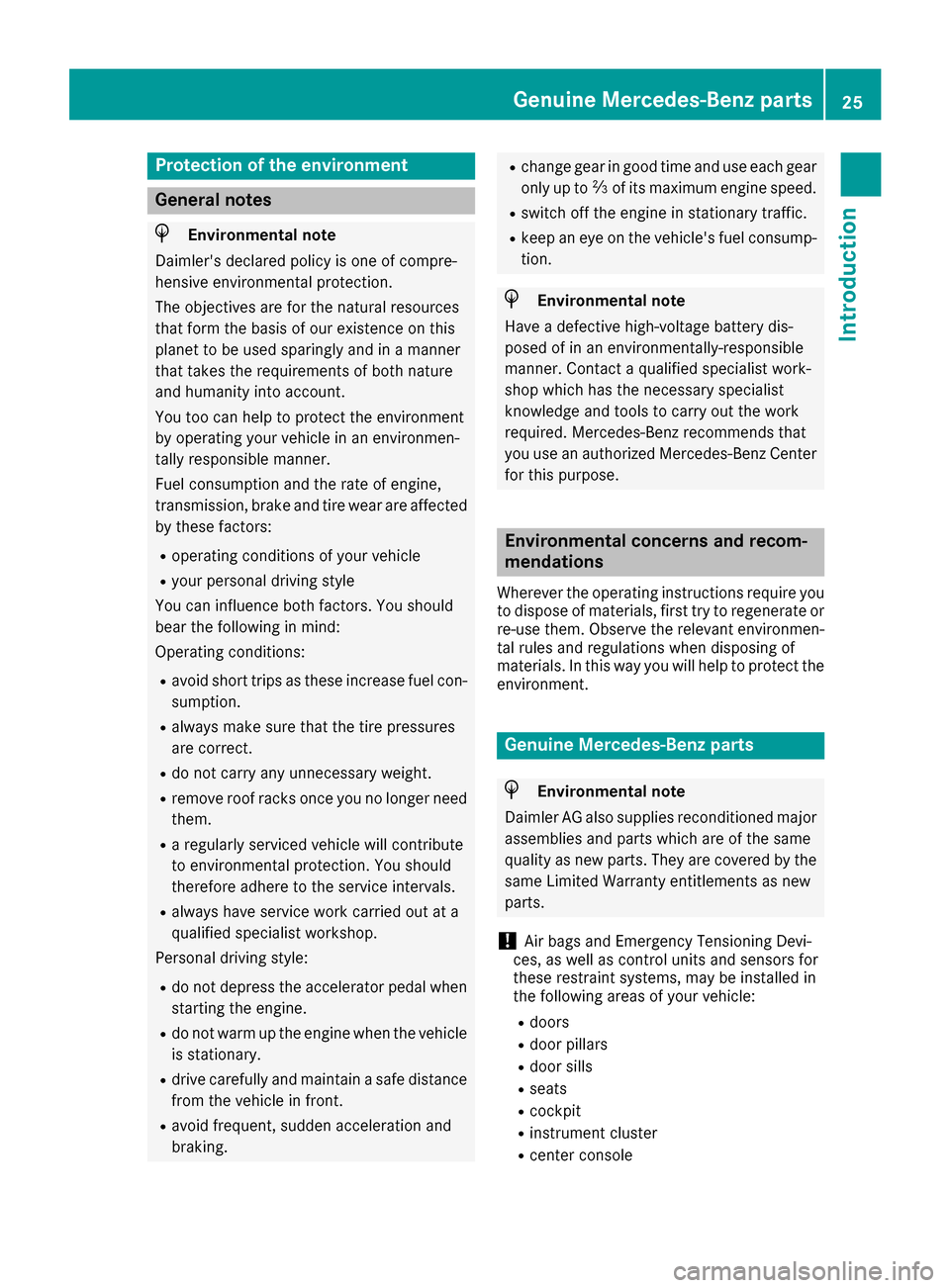
Protection of the environment
General notes
HEnvironmental note
Daimler's declared policy is one of compre-
hensive environmental protection.
The objectives are for the natural resources
that form the basis of our existence on this
planet to be used sparingly and in amanner
that takes the requirements of both nature
and humanity into account.
You too can help to protect the environment
by operating your vehicle in an environmen-
tally responsible manner.
Fuel consumption and the rate of engine,
transmission, brake and tire wear are affected by these factors:
Roperating conditionsofy our vehicle
Ryour personal driving style
You can influence both factors. You should
bear the following in mind:
Operating conditions:
Ravoid short trips as these increase fuel con-
sumption.
Ralways make sure that the tire pressures
are correct.
Rdo not carry any unnecessary weight.
Rremove roof racks once you no longer need
them.
Rar egularly serviced vehicle will contribute
to environmental protection. You should
therefore adhere to the service intervals.
Ralways have service work carried out at a
qualified specialist workshop.
Personal driving style:
Rdo not depress the accelerator pedal when
startin gthe engine.
Rdo not warm up the engine when the vehicle
is stationary.
Rdrive carefully and maintain asafe distance
from the vehicle in front.
Ravoid frequent, sudden acceleration and
braking.
Rchange gear in good time and use each gear
only up to Ôof its maximum engine speed.
Rswitch off the engine in stationary traffic.
Rkeep an eye on the vehicle's fuel consump-
tion.
HEnvironmental note
Have adefective high-voltage battery dis-
posed of in an environmentally-responsible
manner. Contact aqualified specialist work-
shop which has the necessary specialist
knowledge and tools to carry out the work
required. Mercedes-Benz recommends that
you use an authorized Mercedes-Benz Center
for this purpose.
Environmental concerns and recom-
mendations
Wherever the operating instructions require you
to dispose of materials, first try to regenerate or
re-use them. Observe the relevant environmen-
tal rules and regulations when disposing of
materials. In this way you will help to protect the
environment.
Genuine Mercedes-Benz parts
HEnvironmental note
Daimler AG also suppliesr econditioned major
assemblies and parts which are of the same
quality as new parts. They are covered by the
same Limited Warranty entitlements as new
parts.
!Air bags and Emergency Tensioning Devi-
ces, as well as control units and sensors for
these restraint systems, may be installed in
the following areas of your vehicle:
Rdoors
Rdoor pillars
Rdoor sills
Rseats
Rcockpit
Rinstrumentc luster
Rcenter console
Genuine Mercedes-Benz parts25
Introduction
Z
Page 45 of 354
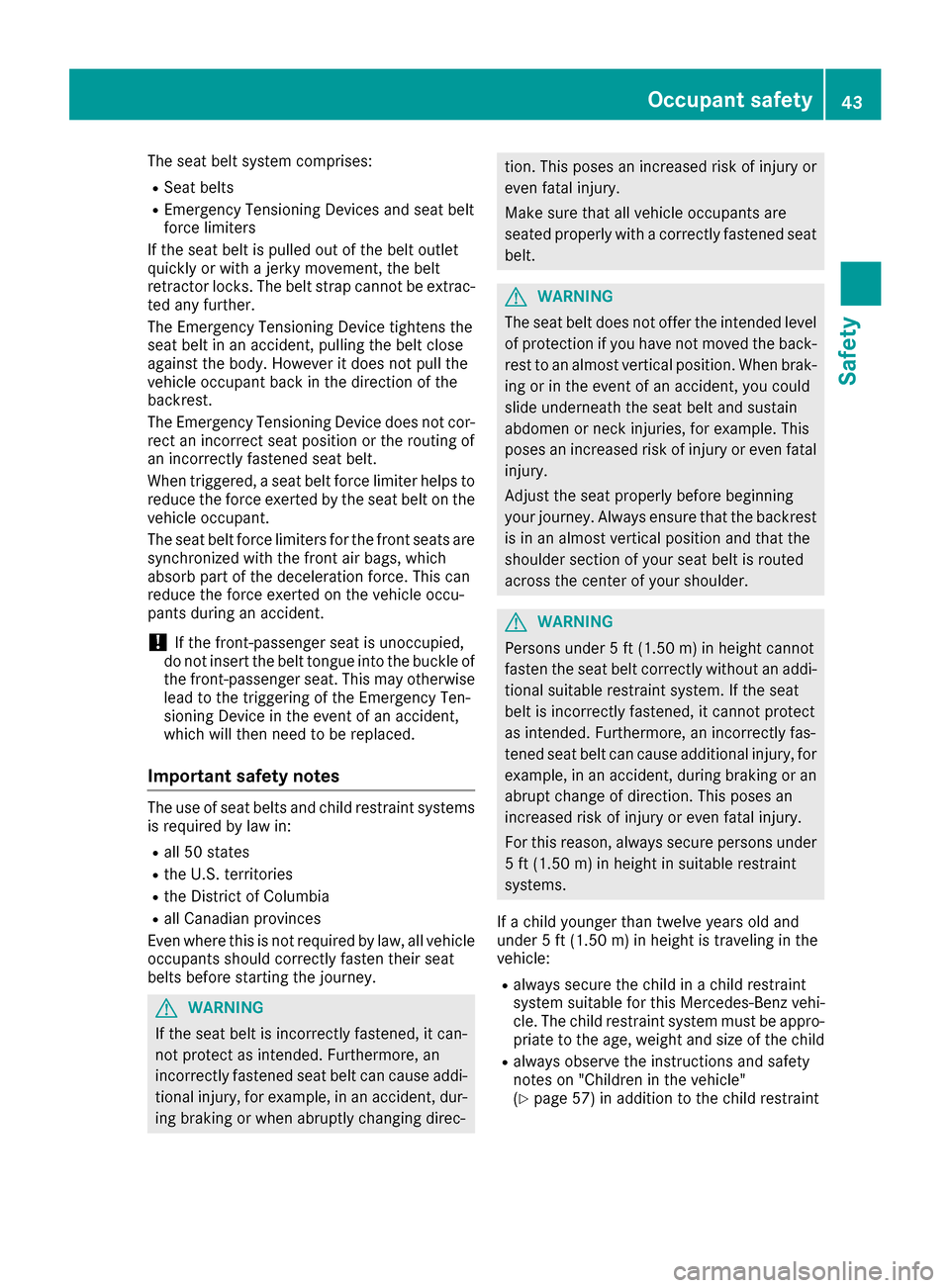
The seat belt system comprises:
RSeat belts
REmergency TensioningDevices and seat belt
force limiters
If the seat belt is pulled out of the belt outlet
quickly or with ajerk ym ovement, the belt
retractor locks. The belt strap cannot be extrac-
ted any further.
The Emergency TensioningD evice tightensthe
seat belt in an accident ,pulling the belt close
against the body. However it does not pull the
vehicle occupant back in the direction of the
backrest.
The Emergency TensioningD evice does not cor-
rect an incorrect seat position or the routing of
an incorrectly fastened seat belt.
When triggered, aseat belt force limiter helps to
reduce the force exerted by the seat belt on the
vehicle occupant.
The seat belt force limiters for the front seats are
synchronized with the front air bags, which
absorb part of the deceleration force. This can
reduce the force exerted on the vehicle occu-
pants during an accident.
!If the front-passenger seat is unoccupied,
do not insert the belt tongue into the buckle of
the front-passenger seat. This may otherwise
lead to the triggerin gofthe Emergency Ten-
sioning Device in the event of an accident,
which will then need to be replaced.
Important safety notes
The use of seat belts and child restraint systems
is required by law in:
Rall 50 states
Rthe U.S. territories
Rthe District of Columbia
Rall Canadian provinces
Even where this is not required by law, all vehicle
occupantss hould correctly fasten their seat
belts before starting the journey.
GWARNING
If the seat belt is incorrectly fastened, it can-
not protec tasintended. Furthermore, an
incorrectly fastened seat belt can cause addi-
tional injury, for example, in an accident ,dur-
ing braking or when abruptly changing direc-
tion. This poses an increased risk of injury or
even fatal injury.
Make sure that all vehicle occupantsa re
seated properly with acorrectly fastened seat
belt.
GWARNING
The seat belt does not offer the intended level of protection if you have not moved the back-
rest to an almost vertical position. When brak-
ing or in the event of an accident ,you could
slide underneath the seat belt and sustain
abdomen or neck injuries, for example. This
poses an increased risk of injury or even fatal injury.
Adjust the seat properly before beginning
your journey. Always ensure that the backrest
is in an almost vertical position and that the
shoulder section of your seat belt is routed
across the center of your shoulder.
GWARNING
Persons under 5ft(1.50 m) in height cannot
fasten the seat belt correctly without an addi- tional suitable restraint system. If the seat
belt is incorrectly fastened, it cannot protect
as intended. Furthermore, an incorrectly fas-
tened seat belt can cause additional injury, for
example, in an accident ,during braking or an
abrupt change of direction .This poses an
increased risk of injury or even fatal injury.
For this reason, alwayss ecure persons under
5ft( 1.50 m) in height in suitable restraint
systems.
If ac hild younger than twelve years old and
under 5ft(1.50 m)in height is travelingint he
vehicle:
Ralways secur ethe child in achild restraint
system suitable for this Mercedes-Ben zvehi-
cle. The child restraint system must be appro-
priatetot he age, weight and size of the child
Ralways observe the instructions and safety
notes on "Children in the vehicle"
(
Ypage 57) in addition to the child restraint
Occupant safety43
Safety
Z
Page 51 of 354
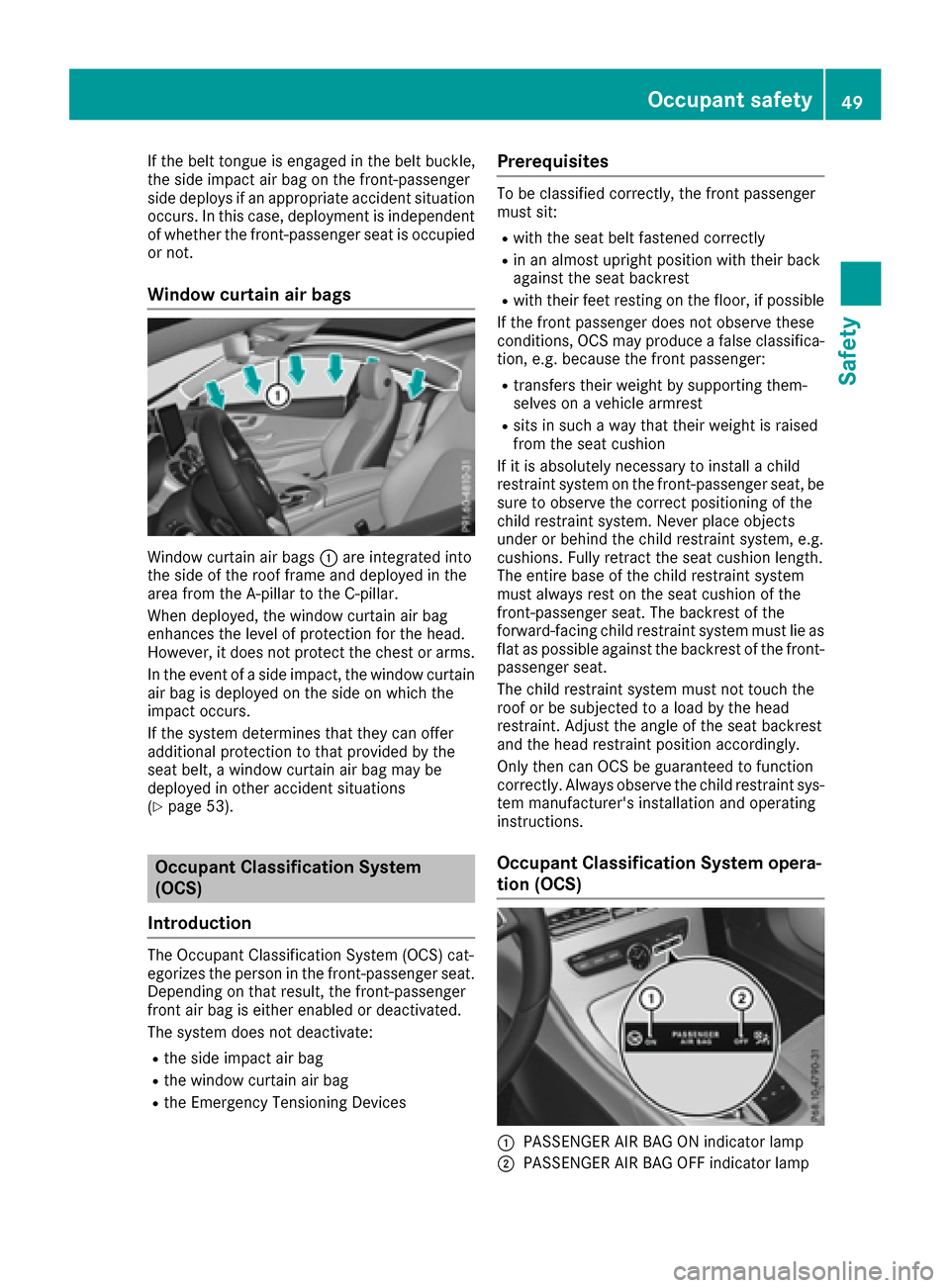
If the belt tongue is engaged in the belt buckle,
the side impact air bag on the front-passenger
side deploys if an appropriate accident situation
occurs. In this case, deployment is independent
of whether the front-passenger seat is occupied
or not.
Window curtain air bags
Window curtain air bags:are integrated into
the side of the roof frame and deployed in the
area from the A-pillartot he C-pillar.
When deployed ,the window curtain air bag
enhances the level of protection for the head.
However, it does not protect the chest or arms.
In the event of aside impact, the window curtain
air bag is deployed on the side on which the
impact occurs.
If the system determines that they can offer
additional protection to that providedbyt he
seat belt, awindow curtain air bag may be
deployed in other accident situations
(
Ypage 53).
Occupant Classification System
(OCS)
Introduction
The Occupant Classification System (OCS) cat-
egorizes the person in the front-passenger seat.
Depending on that result, the front-passenger
front air bag is either enable dordeactivated.
The system does not deactivate:
Rthe side impact air bag
Rthe window curtain air bag
Rthe Emergency Tensioning Devices
Prerequisites
To be classified correctly, the front passenger
must sit:
Rwith the seat belt fastened correctly
Rin an almos tupright positionw ith their back
against the seat backrest
Rwith their feet resting on the floor, if possible
If the front passenger does not observe these
conditions, OCS may produce afalse classifica-
tion, e.g. because the front passenger:
Rtransfers their weight by supporting them-
selves on avehicle armrest
Rsits in such away that their weight is raised
from the seat cushion
If it is absolutely necessary to install achild
restraint system on the front-passenger seat, be
sure to observe the correct positioning of the
child restraint system. Never place objects
under or behind the child restraint system, e.g.
cushions. Full yretract the seat cushio nlength.
The entire base of the child restraint system
must always rest on the seat cushio nofthe
front-passenger seat. The backrest of the
forward-facing child restraint system must lie as
flat as possible against the backrest of the front-
passenger seat.
The child restraint system must not touch the
roof or be subjected to aload by the head
restraint. Adjust the angle of the seat backrest
and the head restraint positiona ccordingly.
Only then can OCS be guaranteed to function
correctly. Alway sobserve the child restraint sys-
tem manufacturer's installation and operating
instructions.
Occupant Classification System opera-
tion (OCS)
:PASSENGER AIR BAG ON indicator lamp
;PASSENGER AIR BAG OFF indicator lamp
Occupant safety49
Safety
Z
Page 55 of 354
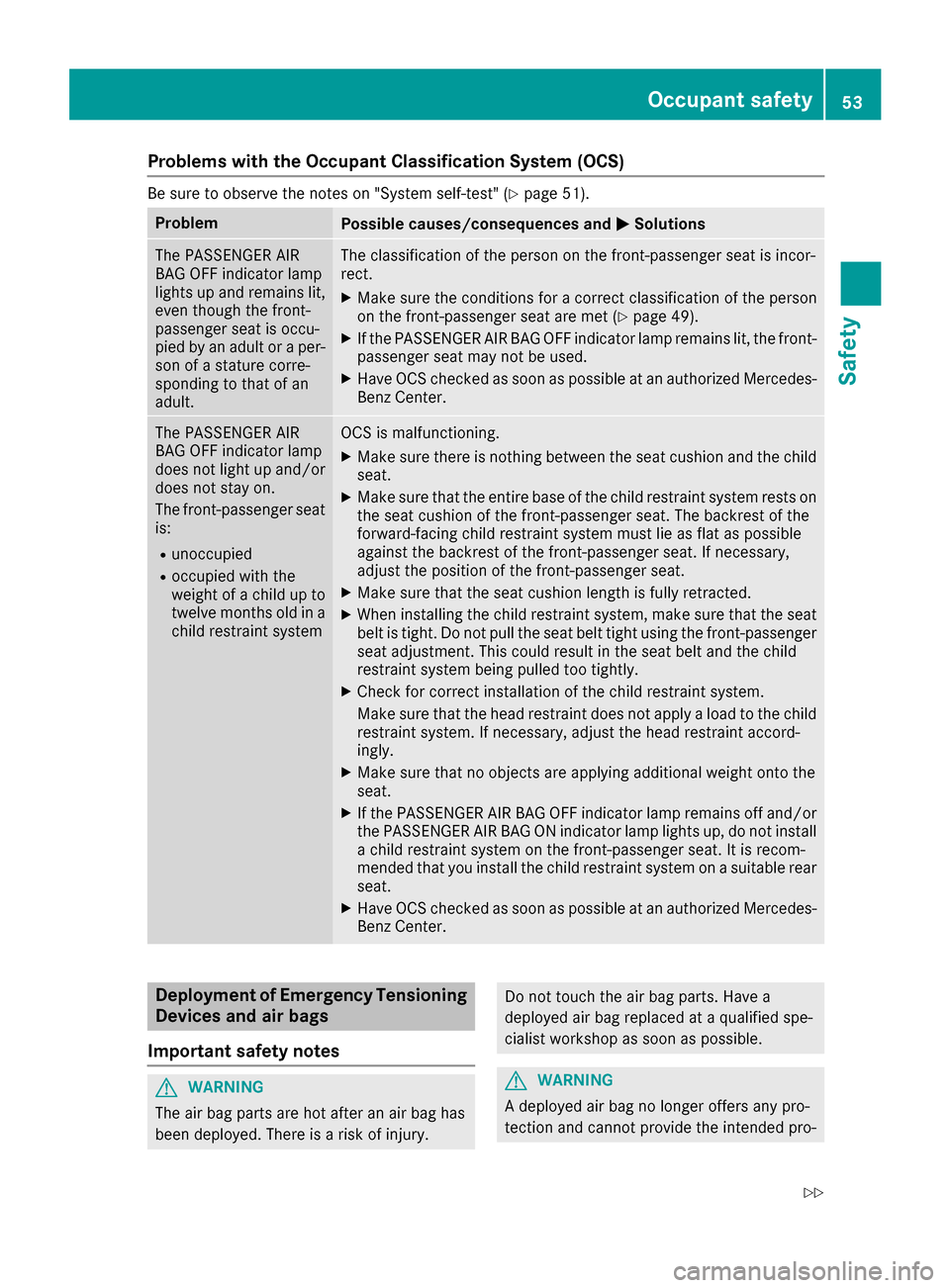
Problems with the Occupant Classification System (OCS)
Be sure to observe the notes on "System self-test"(Ypage 51).
ProblemPossible causes/consequences andMSolutions
The PASSENGER AIR
BAG OFF indicator lamp
lights up and remains lit,
even though the front-
passenger seat is occu-
pied by an adult oraper-
son of astature corre-
sponding to that of an
adult.The classification of the person on the front-passenger seat is incor-
rect.
XMake sure the conditionsf orac orrect classification of the person
on the front-passenger seat are met (Ypage 49).
XIf the PASSENGER AIR BAG OFF indicator lamp remains lit, the front-
passenger seat may not be used.
XHave OCS checked as soon as possible at an authorized Mercedes- Benz Center.
The PASSENGER AIR
BAG OFF indicator lamp
does not light up and/or
does not stay on.
The front-passenger seat
is:
Runoccupied
Roccupied with the
weight of achild up to
twelve months old in a
child restraint system
OCS is malfunctioning.
XMake sure there is nothin gbetween the seat cushion and the child
seat.
XMake sure that the entire base of the child restraint system rests on
the seat cushion of the front-passenger seat. The backrest of the
forward-facing child restraint system must lie as flat as possible
against the backrest of the front-passenger seat. If necessary,
adjust the position of the front-passenger seat.
XMake sure that the seat cushion length is fully retracted.
XWhen installing the child restraint system, make sure that the seat
belt is tight. Do not pull the seat belt tight using the front-passenger seat adjustment .This could result in the seat belt and the child
restraint system being pulled too tightly.
XCheck for correct installation of the child restraint system.
Make sure that the head restraint does not apply aload to the child
restraint system. If necessary, adjust the head restraint accord-
ingly.
XMake sure that no object sare applying additional weight onto the
seat.
XIf the PASSENGER AIR BAG OFF indicator lamp remains off and/or
the PASSENGER AIR BAG ON indicator lamp lights up, do not install ac hild restraint system on the front-passenger seat. It is recom-
mended that you install the child restraint system on asuitable rear
seat.
XHave OCS checked as soon as possible at an authorized Mercedes- Benz Center.
Deployment of Emergency Tensioning
Devices and air bags
Important safety notes
GWARNING
The air bag parts are hot after an air bag has
been deployed. There is arisk of injury.
Do not touch the air bag parts. Have a
deploye dair bag replaced at aqualified spe-
cialist workshop as soon as possible.
GWARNING
Ad eployeda ir bag no longer offers any pro-
tection and cannot provide the intended pro-
Occupant safety53
Safety
Z
Page 59 of 354
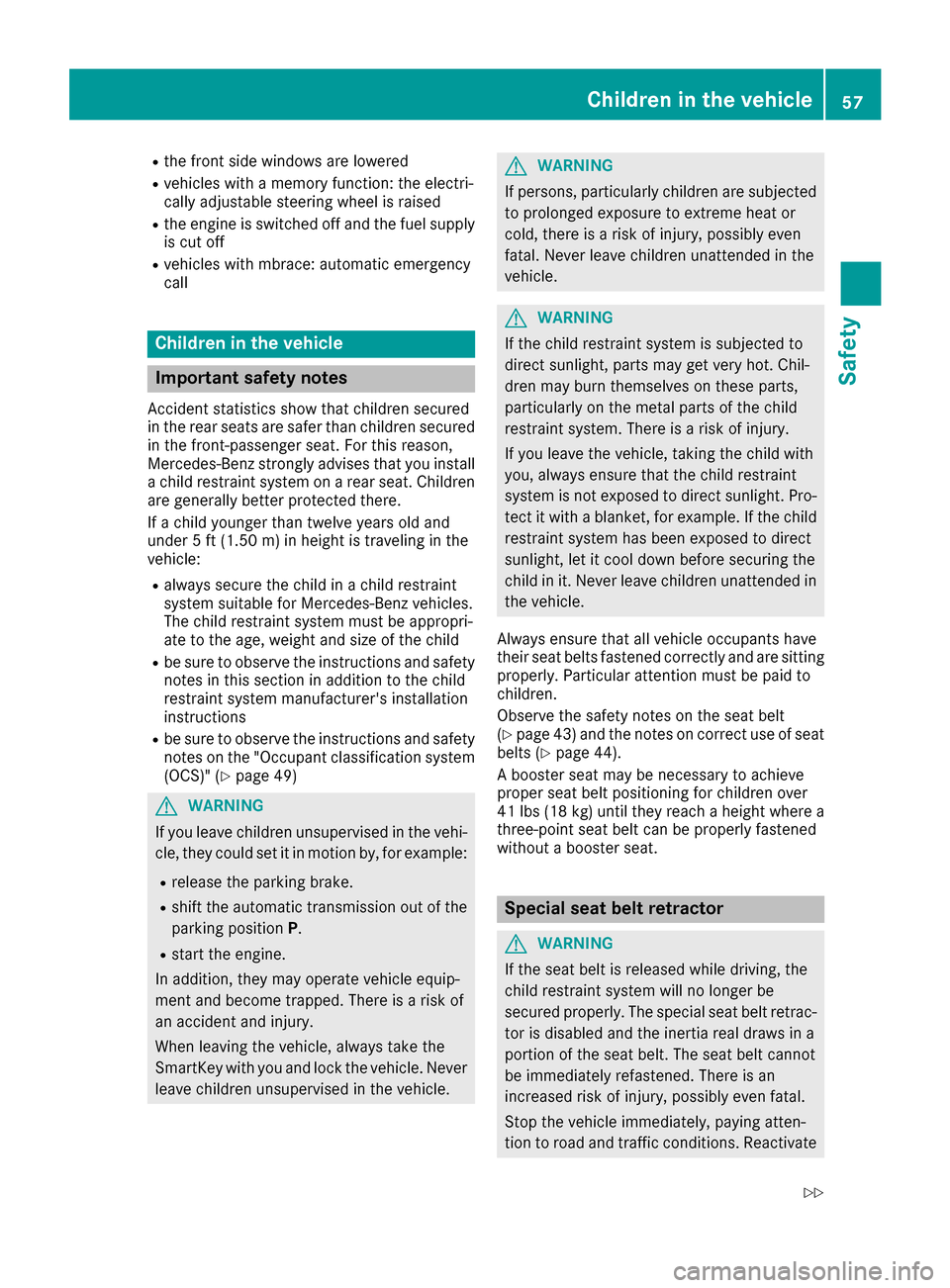
Rthe front side windows arelower ed
Rvehicles with amemory function: the electri-
cally adjustable steering whee lisraised
Rthe engine is switched off and the fuel supply
is cut off
Rvehicles with mbrace :automatic emergency
call
Children in the vehicle
Important safety notes
Accident statistics sho wthatc hildren secured
in the rea rsea ts ar esafer thanc hildren secured
in the front-passenge rseat. For thisr eason,
Mercedes-Benz strongl yadvises thaty ouinstall
ac hild restraint systemonar ears eat. Children
ar eg enerall ybetter protecte dthere.
If ac hild younger thant welve yearsoldand
under 5ft(1.50 m)in height is travelingint he
vehicle:
Ralways secur ethe child in achild restraint
system suitable for Mercedes-Ben zvehicles.
The child restraint system must be appropri-
ate to the age, weight and size of the child
Rbe sure to observe the instructions and safety
notes in this section in addition to the child
restraint system manufacturer'si nstallation
instructions
Rbe sure to observe the instructions and safety
notes on the "Occupant classification system
(OCS)" (
Ypage 49)
GWARNING
If you leave children unsupervised in the vehi-
cle, the ycould set it in motion by, for example:
Rrelease the parking brake.
Rshift the automatic transmission out of the
parking position P.
Rstartthe engine.
In addition ,the ym ay operatev ehicle equip-
menta nd becom etrapped. There is arisk of
an accident and injury.
When leavingt he vehicle, always tak ethe
SmartKey with you and lock the vehicle. Never
leave children unsupervised in the vehicle.
GWARNING
If persons, particularly children are subjected to prolonged exposure to extreme heat or
cold, there is arisk of injury, possibly even
fatal. Never leave children unattended in the
vehicle.
GWARNING
If the child restraint system is subjected to
directs unlight, partsm ay get very hot.C hil-
dren may burn themselves on these parts,
particularly on the metal partsoft he child
restraint system. There is arisk of injury.
If you leave the vehicle, taking the child with
you, always ensure that the child restraint
system is not exposed to directs unlight. Pro-
tec titw ithablanket, for example. If the child
restraint system has been exposed to direct
sunlight, let it cool down befores ecuring the
child in it. Never leave children unattended in
the vehicle.
Always ensure that all vehicle occupant shave
their seat belts fastened correctly and are sitting
properly. Particular attention must be paid to
children.
Observe the safetyn otes on the seat belt
(
Ypage 43) and the notes on correctu se of seat
belts (Ypage 44).
Ab ooster seat may be necessary to achieve
proper seat belt positionin gfor children over
41 lbs (1 8kg)until the yreach aheight where a
three-point seat belt can be properly fastened
without abooster seat.
Specia lseat belt retractor
GWARNING
If the seat belt is released while driving, the
child restraint system will no longer be
secured properly. The special seat belt retrac- tor is disabled and the inertia real draws in a
portion of the seat belt. The seat belt cannot
be immediately refastened. There is an
increased risk of injury, possibly even fatal.
Stop the vehicle immediately, paying atten-
tion to road and traffic conditions. Reactivate
Children in th evehicle57
Safety
Z
Page 61 of 354

The securing systems of child restraint systems
are:
Rthe seat belt system
Rthe LATCH-type (ISOFIX) securing rings
Rthe Top Tether anchorages
If it is absolutely necessary to carry achild on
the front-passenger seat, be sure to observe the
information on the "Occupant Classification
System (OCS)" (
Ypage 49). There you will also
find information on deactivatin gthe front-
passenger front air bag.
All child restraint systems must meet the fol-
lowing standards:
RU.S. Federal Motor Vehicle Safety Standards
213 and 225
RCanadian Motor Vehicle Safety Standards
213 and 210.2
Confirmation that the child restraint system cor-
responds to the standards can be found on an
instruction label on the child restraint system.
This confirmation can also be found in the instal-
lation instructions that are included with the
child restraint system.
Observe the warning labels in the vehicle inte-
rior and on the child restraint system.
LATCH-type( ISOFIX) child seat secur-
ing system
GWARNING
LATCH-type (ISOFIX) child restraint systems
do not offer sufficient protective effect for
children whose weight is greater than 48 lbs
(22 kg )who are secured using the safety belt
integrated in the child restraint system. In the
event of an accident ,achild might not be
restrained correctly. This poses an increased
risk of injury or even fatal injury.
If the child weighs more than 48 lbs (22 kg),
only use LATCH-type (ISOFIX) child restraint
systems with which the child is also secured
with the vehicle seat belt. Also secure the
child restraint system with the Top Tether
belt, if available.
Always comply with the manufacturer's instal-
lation and operating instructions for the child
restraint system used. Before every trip, make sure that the LATCH-
type (ISOFIX) child restraint system is engaged
correctly in both LATCH-type (ISOFIX) securing
rings.
XInstall the LATCH-type (ISOFIX) child restraint
system on both LATCH-type (ISOFIX) securing
rings :.
ISOFIX is astandardized securing system for
specially designed child restraint systems on
the rear seats. LATCH-type (ISOFIX) securing
rings for two LATCH-type (ISOFIX) child restraint
systems are installed on the left and right of the
rear seats.
Non-LATCH-type (ISOFIX) child seats may also
be used and can be installed using the vehicle's
seat belt system. Install the child seat according
to the manufacturer's instructions.
Top Tether
Introduction
Top Tether provides an additional connection
between the child restraint system secured with
aL ATCH-type (ISOFIX) system and the vehicle.
This helps reduce the risk of injury even further.
If the child restraint system is equipped with a
Top Tether belt, this should alwaysbeu sed.
Important safety notes
GWARNING
If the rear seat backrest sare not locked, they
could fold forwards in the event of an acci-
dent, heavy braking or sudden changes of
direction .Asaresult, child restraint systems
cannot perform their intended protective
function. Rear seat backrest sthat are not
locked can also cause additional injuries, e.g.
Children in the vehicle59
Safety
Z
Page 161 of 354
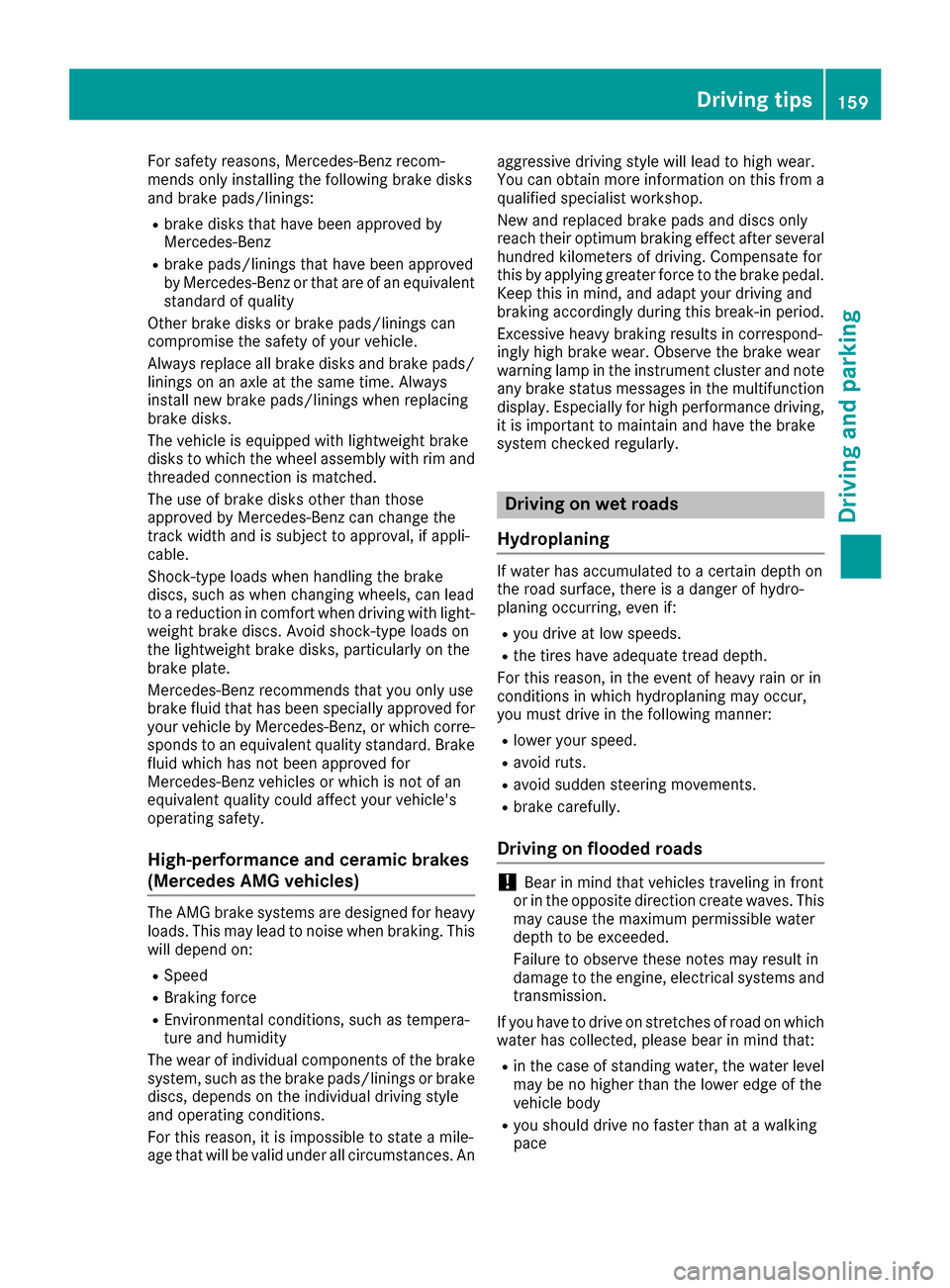
For safety reasons, Mercedes-Benz recom-
mends only installing the following brake disks
and brake pads/linings:
Rbrake disks that havebeena pproved by
Mercedes-Benz
Rbrake pads/lining sthat hav ebeena pproved
by Mercedes-Benz or that are of an equivalent
standard of quality
Other brake disks or brake pads/lining scan
compromise the safety of your vehicle.
Alway sreplace al lbrake disks and brake pads/
linings on an axl eatthe sam etime. Always
install new brake pads/lining swhenr eplacing
brake disks.
The vehicle is equipped with lightweight brake
disks to which the wheel assembly with rim and
threaded connectio nismatched.
The use of brake disks other than those
approved by Mercedes-Benz can chang ethe
track width and is subject to approval ,ifappli-
cable.
Shock-typ eloads whe nhandling the brake
discs, such as whe nchanging wheels ,can lead
to areduction in comfortw hend riving with light-
weigh tbrake discs. Avoid shock-type loads on
the lightweight brake disks, particularly on the
brake plate.
Mercedes-Benz recommends that yo uonly use
brake fluid that has bee nspeciall yapproved for
your vehicle by Mercedes-Benz, or which corre-
sponds to an equivalent quality standard .Brake
fluid which has not bee napproved for
Mercedes-Benz vehicles or which is not of an
equivalent quality could affect your vehicle's
operating safety.
High-performance and ceramic brakes
(Mercedes AMG vehicles)
The AMG brake systems are designe dfor heavy
loads. Thism ay leadtonoisew henb raking. This
will depend on:
RSpeed
RBraking force
REnvironmental conditions, such as tempera-
ture and humidity
The wear of individua lcomponents of the brake
system, such as the brake pads/lining sorbrake
discs, depends on the individua ldriving style
and operating conditions.
For this reason, it is impossible to state amile-
ag ethat will be valid under al lcircumstances. An aggressive driving styl
ewilll ea dtoh ighw ear.
You can obtain more information on this from a
qualified specialist workshop.
New and replaced brake pads and discs only
reach thei roptimum braking effect afte rseveral
hundred kilometers of driving. Compensate for
this by applying greater force to the brake pedal.
Kee pthis in mind ,and adap tyou rd riving and
braking accordingly during this break-in period.
Excessive heavy braking results in correspond-
ingl yhighb rake wear. Observe the brake wear
warning lamp in the instrument cluster and note
any brake statu smessages in the multifunction
display. Especiall yfor hig hperformance driving,
it is important to maintain and hav ethe brake
system checked regularly.
Drivin gonw etroads
Hydroplaning
If water has accumulated to acertain depth on
the roads urface,there is adanger of hydro-
planing occurring, even if:
Ryo ud rive at low speeds.
Rthe tires hav eadequate treadd epth.
For this reason, in the event of heavy rai norin
conditions in which hydroplaning may occur,
yo um ustd rive in the following manner:
Rlower your speed.
Ravoid ruts.
Ravoid sudden steering movements.
Rbrake carefully.
Drivin gonfloodedroads
!Bearinm ind that vehicles traveling in front
or in the opposite directio ncreate waves. This
may cause the maximum permissibl ewater
depth to be exceeded.
Failure to observe these notes may result in
damag etothe engine, electricals ystems and
transmission.
If yo uhavetod rive on stretche sofroadonw hich
water has collected ,please bea rinmind that:
Rin the case of standing water, the water level
may be no higher than the lower edg eofthe
vehicle body
Ryo us hould drive no faster than at awalking
pace
Drivin gtips159
Drivin gand parking
Z
Page 232 of 354
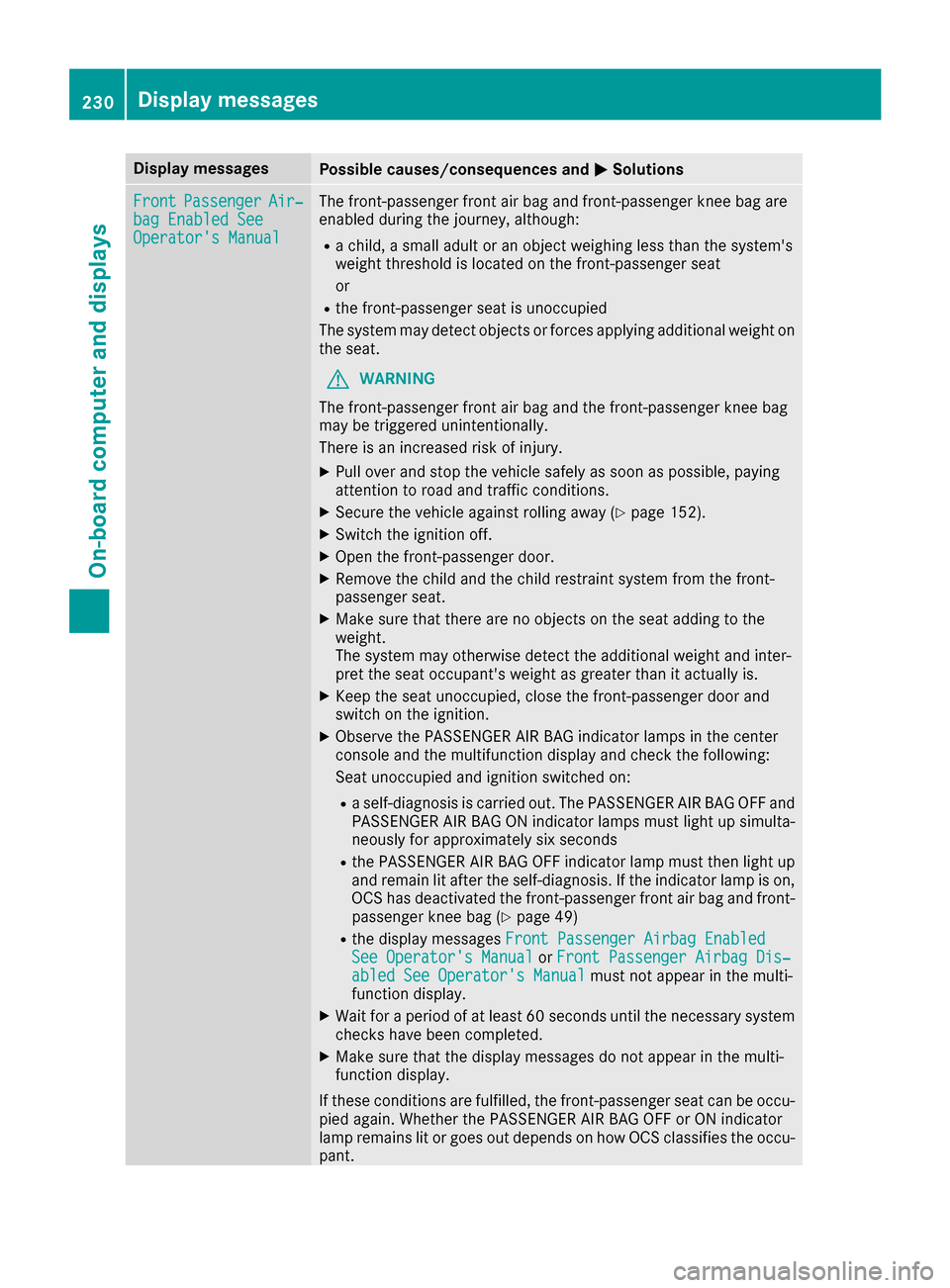
Display messagesPossible causes/consequences andMSolutions
FrontPassengerAir‐bag Enable dSeeOperator' sManual
The front-passenger fron tair bag and front-passenger knee bag are
enabled during th ejou rney, although:
Rac hild, asmall adult or an objec tweighing less than th esystem' s
weigh tthreshold is locate donthefront-passenger seat
or
Rth ef ront-pa ssenger seat is unoccupied
The system may detec tobjects or force sapplyin gadditional weigh ton
th es eat .
GWARNIN G
The front-passenger fron tair bag and th efront-pa ssenger knee bag
may be triggered unintentionally.
There is an increased ris kofinjury.
XPull ove rand stop th evehicl esafely as soo naspossible, payin g
attention to roa dand traffic conditions.
XSecur ethe vehicl eagainst rollin gaway (Ypage 152).
XSwitc hthe ignition off .
XOpenthe front-passenger door .
XRemove thechild and th echild restrain tsystem from th efront -
passenger seat .
XMakesuret hatthe re are no objects on th eseat addin gtothe
weight.
The system may otherwise detec tthe additional weigh tand inter-
pre tthe seat occupant's weigh tasgreatertha nita ctually is.
XKeepthe seat unoccupied ,close th efront-pa ssenger door and
switch on th eignition .
XObserv ethe PASSENGER AI RBAG indicator lamp sinthecenter
console and th emultifunction display and chec kthe following:
Seat unoccupied and ignition switched on :
Raself-diagnosis is carrie dout.T he PASSENGER AI RBAG OFFa nd
PASSENGER AI RBAG ON indicator lamp smustligh tups imulta-
neousl yfor approximately six seconds
RtheP ASSENG ER AIRBAG OFFindicator lamp mus tthe nligh tup
and remain lit after th eself-diagnosis .Iftheindicator lamp is on ,
OCS has deactivated th efront-pa ssenger fron tair bag and front-
passenger knee bag (
Ypage 49)
Rthed isplay message sFront Passenger Airbag Enable dSee Operator'sManualorFront Passenger Airbag Dis ‐abled See Operator'sManualmus tnotappear in th emulti-
function display.
XWait for aperiod of at least 60 seconds until th eneces sarysystem
checks hav ebeen completed.
XMak esuret hatthe display message sdonotappear in th emulti-
function display.
If these condition sare fulfilled ,the front-passenger seat can be occu-
pied again .Whether th ePASSENG ER AIRBAG OFForONi ndicator
lamp remain slit or goe sout depend sonhow OCS classifies th eoccu-
pant.
230Display messages
On-boardc omputer andd isplays
Page 270 of 354

Stowage areas
Loading guidelines
GWARNING
Combustion engines emit poisonous exhaust
gases such as carbon monoxide. Exhaust
gases can enter the vehicle interior if the
trunk lid is open when the engine is running,
especially if the vehicle is in motion. There is a
risk of poisoning.
Always switch off the engine before opening
the trunk lid. Never drive with the trunk lid
open.
GWARNING
If objects, luggage or loads are not secured or
not secured sufficiently, they could slip, tip
over or be flung around and thereby hit vehicle
occupants. There is arisk of injury, particu-
larly in the event of sudden braking or asud-
den change in direction.
Always store object ssothat they cannot be
flung around. Secure objects, luggage or
loads against slipping or tipping before the
journey.
GWARNING
The exhaust tail pipe and tail pipe trim can
become very hot. If you come into contact
with these parts of the vehicle, you could burn
yourself. There is arisk of injury.
Always be particularly careful around the
exhaust tail pipe and the tail pipe trim. Allow
these components to cool down before touch-
ing them.
The handling characteristics of aladen vehicle
are dependent on the distribution of the load
within the vehicle. For this reason, you should
observe the following notes when transporting a
load:
RNever exceed the maximum permissible
gross vehicle mass or the gross axle weight
rating for the vehicle (including occupants).
The values are specified on the vehicle iden- tification plate on the B-pillar of the driver's
door.
RThe trunk is the preferred place to carry
objects.
RPosition heavy loads as far forwards as pos-
sible and as low down in the trunk as possible.
RThe load must not protrude above the upper
edge of the seat backrests.
RAlways place the load behind unoccupied
seats if possible.
RSecure the load with sufficiently stron
gand
wear-resistant tie-downs. Pad sharp edges for
protection.
Stowage spaces
Important safety notes
GWARNING
If object sinthe passenger compartmenta re
stowed incorrectly, they can slide or be
thrown around and hit vehicle occupants. In
addition, cupholders, open stowage spaces
and mobile phone brackets cannot always
retain all object sthey contain. There is arisk
of injury, particularly in the event of sudden
braking or asudden change in direction.
RAlways stow object ssothat they cannot be
thrown around in such situations.
RAlways make sure that object sdonot pro-
trude from stowage spaces, parcel nets or
stowage nets.
RClose the lockable stowage spaces before
startin gajourney.
RAlways stow and secure heavy, hard, poin-
ted, sharp-edged, fragile or bulky object sin
the trunk.
Observe the loading guidelines (
Ypage 268).
268Stowage areas
Stowage and features